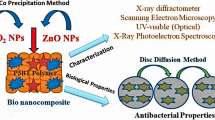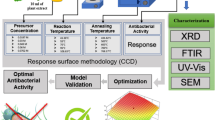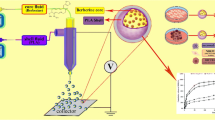Abstract
Benzylisothiocynate also referred to as BITC is a compound which is commonly found in Cruciferae plants. This chemical moiety falls under the category of Isothiocynates (ITCs), and is known to possess superior antibacterial properties. Hence, endeavors have been made in the present research to encapsulate benzyl isothiocynate (BITC) within the framework of polymeric nanoparticles to enhance its potency, stability, safety, and biocompatibility. The study also aimed at fabricating a nanoparticulate system with engineered release characteristics so that the susceptibility of BITC in evoking a bactericidal response towards E. coli can be enhanced. To attain an optimal system with desired critical quality attributes [CQAs (particle size, entrapment efficiency and release)] all the requisite critical material attributes [CMAs (amount of polymer, and concentration of surfactant)] were optimized using central composite design (CCD). An overall assessment of the physicochemical characteristics of fabricated PLGA nanoparticles containing BITC viz. BITC-PLGA NPs were accomplished using DLS, FE-SEM, UV–Vis, and ATR-FTIR spectroscopy. The BITC-PLGA NPs were found to be 106.2 ± 1.78 nm in size, and has a surface charge of − 16.3 ± 0.64 mV. The BITC-PLGA NPs were found to be homogenous as the DLS analysis revealed a PDI value of 0.353 ± 0.008. A significantly high entrapment efficiency and percentage loading (~ 74 and 32%) along with a sustained release of BITC (~ 64.2 (pH 5.5)–(pH 5.5), and 83.8 (pH 7.4) %) was obtained from BITC-PLGA NPs. The antibacterial assay also pointed towards a safe and efficient delivery system which can further prove to be a pioneer in the upcoming times.


Similar content being viewed by others
References
Armentano I, Dottori M, Fortunati E, Mattioli S, Kenny J (2010) Biodegradable polymer matrix nanocomposites for tissue engineering: a review polymer degradation and stability 95:2126–2146
Balouiri M, Sadiki M, Ibnsouda SK (2016) Methods for in vitro evaluating antimicrobial activity: a review. J Pharm Anal 6:71–79
Beg S, Saini S, Bandopadhyay S, Katare O, Singh B (2018) QbD-driven development and evaluation of nanostructured lipid carriers (NLCs) of Olmesartan medoxomil employing multivariate statistical techniques. Drug Dev Ind Pharm 44:407–420
Bhujbal SV, de Vos P, Niclou SP (2014) Drug and cell encapsulation: alternative delivery options for the treatment of malignant brain tumors. Adv Drug Deliv Rev 67:142–153
Bohrey S, Chourasiya V, Pandey A (2016) Polymeric nanoparticles containing diazepam: preparation, optimization, characterization, in vitro drug release and release kinetic study. Nano Converg 3:3
Danhier F, Ansorena E, Silva JM, Coco R, Le Breton A, Préat V (2012) PLGA-based nanoparticles: an overview of biomedical applications. J Control Release 161:505–522
Desai K, Park H (2005) Preparation of cross-linked chitosan microspheres by spray drying: effect of cross-linking agent on the properties of spray dried microspheres. J Microencapsul 22:377–395
Dewangan HK, Pandey T, Maurya L, Singh S (2018) Rational design and evaluation of HBsAg polymeric nanoparticles as antigen delivery carriers. Int J Biol Macromol 111:804–812
Dufour V, Stahl M, Baysse C (2015) The antibacterial properties of isothiocyanates. Microbiology 161:229–243
Encinas-Basurto D et al (2017) Poly (lactic-co-glycolic acid) nanoparticles for sustained release of allyl isothiocyanate: characterization, in vitro release and biological activity. J Microencapsul 34:231–242
Fathi M, Mozafari M-R, Mohebbi M (2012) Nanoencapsulation of food ingredients using lipid based delivery systems. Trends Food Sci Technol 23:13–27
Fernandes R, Gracias DH (2012) Self-folding polymeric containers for encapsulation and delivery of drugs. Adv Drug Deliv Rev 64:1579–1589
Francis S, Joseph S, Koshy EP, Mathew B (2018) Microwave assisted green synthesis of silver nanoparticles using leaf extract of elephantopus scaber and its environmental and biological applications. Artif Cells Nanomed Biotechnol 46:795–804
Gaurav P, Yuanyuan S, Juanjuan Z, Xingcai Z, Stefano L (2018) Nano-carriers for targeted delivery and biomedical imaging enhancement. Ther Deliv 9:451–468
Gonzalez-Pizarro R, Silva-Abreu M, Calpena AC, Egea MA, Espina M, García ML (2018) Development of fluorometholone-loaded PLGA nanoparticles for treatment of inflammatory disorders of anterior and posterior segments of the eye. Int J Pharm 547(1–2):338–346
Hanschen FS, Brüggemann N, Brodehl A, Mewis I, Schreiner M, Rohn S, Kroh LW (2012) Characterization of products from the reaction of glucosinolate-derived isothiocyanates with cysteine and lysine derivatives formed in either model systems or broccoli sprouts. J Agric Food Chem 60:7735–7745
Hecht SS (1999) Chemoprevention of cancer by isothiocyanates, modifiers of carcinogen metabolism. J Nutr 129:768S–774S
Ibarra J, Melendres J, Almada M, Burboa MG, Taboada P, Juárez J, Valdez MA (2015) Synthesis and characterization of magnetite/PLGA/chitosan nanoparticles. Mat Res Express 2:095010
Jang SC et al (2013) Bioinspired exosome-mimetic nanovesicles for targeted delivery of chemotherapeutics to malignant tumors. ACS Nano 7:7698–7710
Jiang Z-T, Zhang Q-F, Tian H-L, Li R (2006) The reaction of allyl isothiocyanate with hydroxyl/water and b-cyclodextrin using ultraviolet spectrometry. Food Technol Biotechnol 44:e7
Khoobchandani M, Bansal P, Medhe S, Ganesh N, Srivastava M (2012) Antioxidant and antimutagenic activities of isothiocyanates rich seed oil of Eruca sativa plant. In: Khemani LD, Srivastava MM, Srivastava S (eds) Chemistry of phytopotentials: health, energy and environmental perspectives. Springer, Berlin, Heidelberg, pp 47–51
Kunyi L et al (2018) Construction of functional nanonetwork-structured carbon nitride with Au nanoparticle yolks for highly efficient photocatalytic applications. Chem Comm 54:7159–7162
Li W, Liu X, Yang Q, Zhang N, Du Y, Zhu H (2015) Preparation and characterization of inclusion complex of benzyl isothiocyanate extracted from papaya seed with β-cyclodextrin. Food Chem 184:99–104
Li Y et al (2019) Rational design of silver gradient for studying size effect of silver nanoparticles on contact killing. ACS Biomat Sci Eng 5:425–431
Liu TT, Yang TS (2010) Stability and antimicrobial activity of allyl isothiocyanate during long-term storage in an oil-in-water emulsion. J Food Sci 75:C445–C451
Lü J-M, Wang X, Marin-Muller C, Wang H, Lin PH, Yao Q, Chen C (2009) Current advances in research and clinical applications of PLGA-based nanotechnology. Expert Rev Mol Diagn 9:325–341
Mendyk A, Jachowicz R (2007) Unified methodology of neural analysis in decision support systems built for pharmaceutical technology. Expert Syst Appl 32:1124–1131
Mennicke W, Görler K, Krumbiegel G, Lorenz D, Rittmann N (1988) Studies on the metabolism and excretion of benzyl isothiocyanate in man. Xenobiotica 18:441–447
Ohta Y, Matsui Y, Osawa T, Kawakishi S (2004a) Retarding effects of cyclodextrins on the decomposition of organic isothiocyanates in an aqueous solution. Biosci Biotechnol Biochem 68:671–675
Ohta Y, Takatani K, Kawakishi S (2004b) Effects of ionized cyclodextrin on decomposition of allyl isothiocyanate in alkaline solutions. Biosci Biotechnol Biochem 68:433–435
Prashar A, Siddiqui F, Singh AK (2012) Synthetic and green vegetable isothiocyanates target red blood leukemia cancers. Fitoterapia 83:255–265
Qhattal HSS, Wang S, Salihima T, Srivastava SK, Liu X (2011) Nanoemulsions of cancer chemopreventive agent benzyl isothiocyanate display enhanced solubility, dissolution, and permeability. J Agric Food Chem 59:12396–12404
Rozhkova EA, Ulasov I, Lai B, Dimitrijevic NM, Lesniak MS, Rajh T (2009) A high-performance nanobio photocatalyst for targeted brain cancer therapy. Nano Lett 9:3337–3342
Saka OM, Öz UC, Küçüktürkmen B, Devrim B, Bozkır A (2018) Central composite design for optimization of zoledronic acid loaded PLGA nanoparticles. J Pharm Innov 80:1–12
Sharma S, Parmar A, Kori S, Sandhir R (2016) PLGA-based nanoparticles: a new paradigm in biomedical applications. TrAC Trends Anal Chem 80:30–40
Sharma S, Parmar A, Bhardwaj R, Kaur T (2018) Design and characterization of apocynin loaded PLGA nanoparticles and their in vivo efficacy in hyperoxaluric rats. Curr Drug Deliv 15(7):1020–1027
Shiguo C et al (2019) Insight into multifunctional polyester fabrics finished by one-step ecofriendly strategy. Chem Eng J 358:634–642
Sofrata A, Santangelo EM, Azeem M, Borg-Karlson A-K, Gustafsson A, Pütsep K (2011) Benzyl isothiocyanate, a major component from the roots of Salvadora persica is highly active against Gram-negative bacteria. PLoS One 6:e23045
Wang L, Hu C, Shao L (2017) The antimicrobial activity of nanoparticles: present situation and prospects for the future. Int J Nanomed 12:1227
Wanjing Z et al (2018) Cytocompatible—chitosan based multi-network hydrogels with antimicrobial, cell anti-adhesive and mechanical properties. Carbohydr Polym 202:246–257
Yuan H-N, Yao S-J, Shen L-Q, Mao J-W (2009) Preparation and characterization of inclusion complexes of β-cyclodextrin−BITC and β-cyclodextrin−PEITC. Ind Eng Chem Res 48:5070–5078
Acknowledgements
The authors recognize DST PURSE grant for monetary help. The authors need to extraordinarily offer their thanks towards Dr. Vipasha Sharma and Shikha Kapil (University Institute of Biotechnology, Chandigarh University, Gharuan (Punjab), India) for their consistent help in performing antibacterial activity. We additionally stretch out our vote of gratitude to the SAIF/CIL and CIIPP, Panjab University (Chandigarh), India, for providing FE-SEM, EDS, and DLS facilities, respectively.
Author information
Authors and Affiliations
Corresponding author
Ethics declarations
Conflict of interest
The authors reported no potential conflict of interest.
Electronic supplementary material
Below is the link to the electronic supplementary material.
Rights and permissions
About this article
Cite this article
Parmar, A., Kaur, G., Kapil, S. et al. Central composite design-based optimization and fabrication of benzylisothiocynate-loaded PLGA nanoparticles for enhanced antimicrobial attributes. Appl Nanosci 10, 379–389 (2020). https://doi.org/10.1007/s13204-019-01185-0
Received:
Accepted:
Published:
Issue Date:
DOI: https://doi.org/10.1007/s13204-019-01185-0




